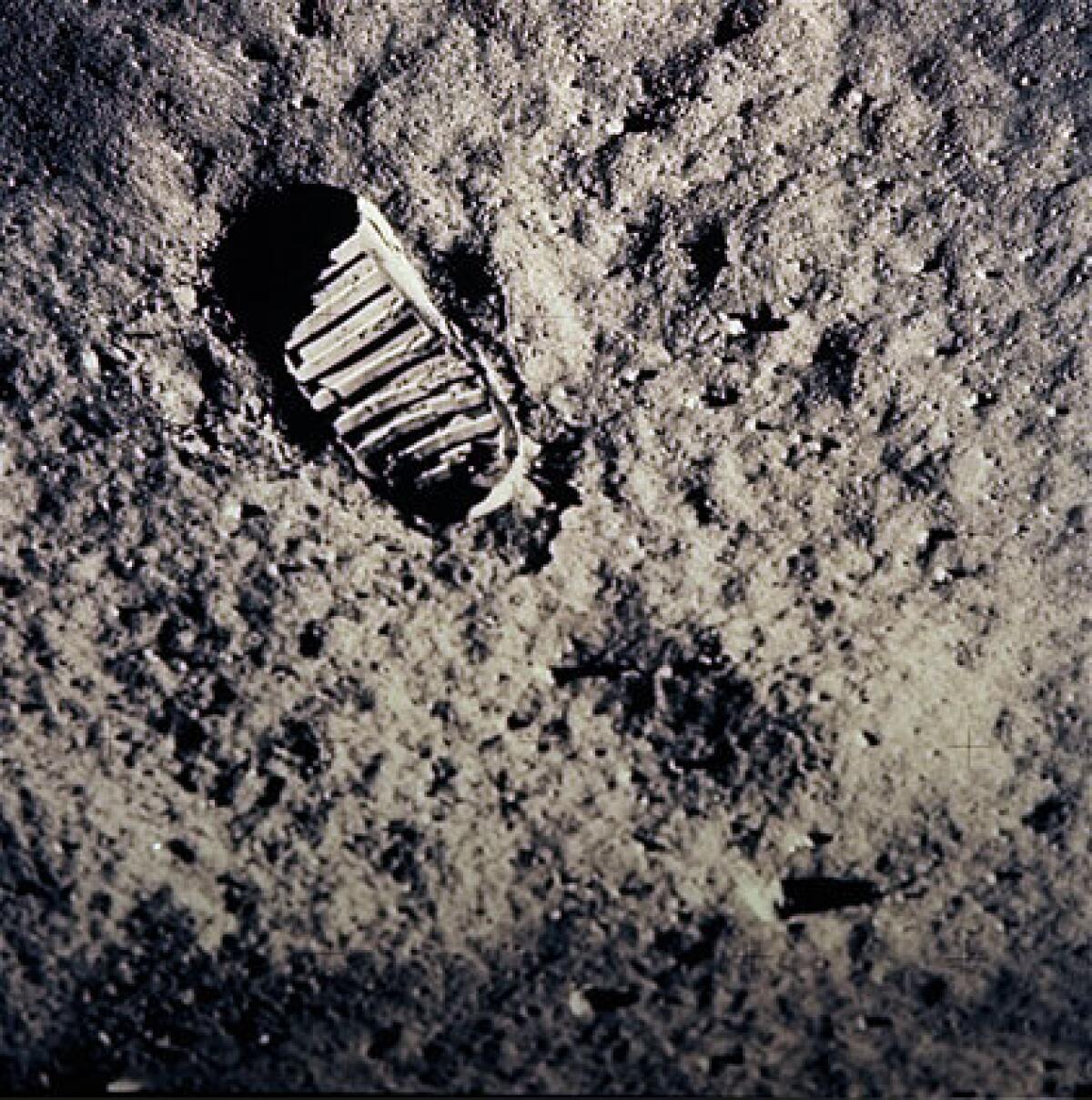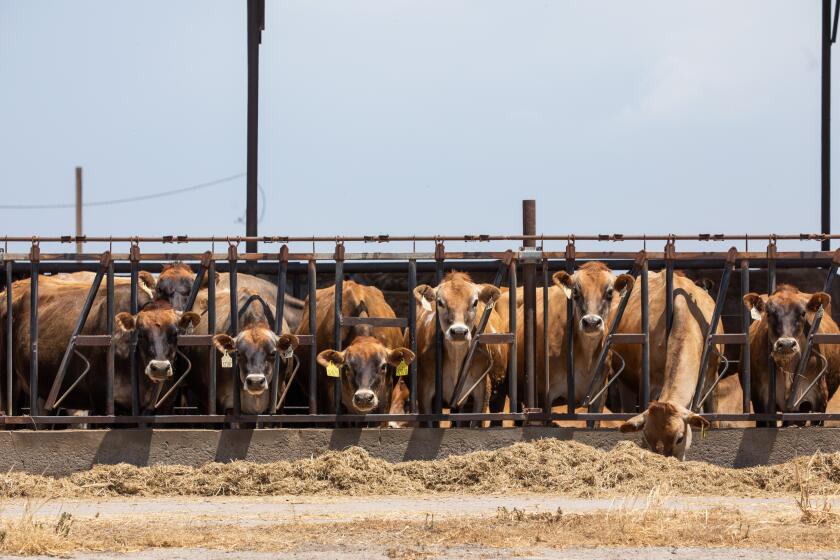Neil Armstrong was the first man to walk on the moon. Who will be the first woman?

- Share via
Fifty years after a military test pilot made the first striated boot prints in the thick gray powder of the lunar surface, NASA has an ambitious plan to send humans back to the moon by 2024.
But this time there’s a twist.
The next time a pair of astronauts set foot on the moon, the space agency has vowed that at least one of them will be a woman.
“I think most women would say it’s about time,” said former astronaut Janet Kavandi , director of NASA’s Glenn Research Center in Cleveland. “Women have been in the astronaut corps for decades now. We’ve gone everywhere else our male counterparts have gone.”
NASA is so serious about sending a woman to the moon that it has named its new lunar program Artemis. In Greek mythology, Artemis is the goddess of the moon and twin sister of the sun god Apollo.
“Having women astronauts on the moon is something that is long overdue,” said NASA administrator Jim Bridenstine. “And because we have this very diverse, highly qualified astronaut corps, we can make that a reality.”
Jeff Hoffman, another former astronaut who’s now a professor at MIT, said that sending a woman to walk on the moon would be deeply symbolic.
“When people ask when I knew I wanted to be an astronaut, I always say that like every other red-blooded boy, I was inspired by the men who flew on Apollo,” he said. “Unfortunately, the red-blooded girls didn’t have those role models.”
Between 1969 and 1972, a total of 12 humans walked on the moon. All of them were American, white and male.
“It was a very homogenous group,” former astronaut and NASA administrator Charles Bolden said in a speech honoring the 50th anniversary of Apollo 11.

NASA started recruiting astronauts in 1959, focusing first on military test pilots. All of them were men.
The first six women admitted to the astronaut corps joined in 1978. Among them was Sally Ride, who became the first American woman to fly in space in 1983.
Today, there are 12 women in NASA’s active astronaut corps, along with 26 men. If NASA keeps to its Artemis timeline, one of these women is likely to become the first female moon-walker.
When it comes time to select this woman, officials at the space agency will look for someone who is resilient, a good team player, in excellent physical shape and undaunted by risk. She must stay cool in the face of adversity and tackle unforeseen problems calmly and methodically.
That doesn’t narrow the field much.
“You could pick just about anybody in the office and they would be successful,” Kavandi said. “We have vetted them so much just to get in.”
This history-making woman will probably have spent at least four to six months aboard the International Space Station, giving mission planners lots of data on how she performs in microgravity: Does she sleep well in space? Does she suffer from space sickness, an ailment that resembles motion sickness?
“Space effects everybody differently,” said Dorit Donoviel, director of the Translational Research Institute for Space Health at Baylor College of Medicine in Houston. “They are not going to send a complete rookie.”
In making the selection, the chief of the astronaut office also will consider how the astronauts perform during training, as well as the skills that are most needed for that first mission and who else will be along for the ride.
“You want to take into account the diversity of the crew,” Kavandi said. “You are not going to send two medical doctors or two military pilots.”
Hoffman has flown in space with both men and women. In his experience, men and women perform equally well.
“We have solid evidence that everyone can do the job,” Hoffman said. “We don’t change the job because of the sex of the astronaut. We change the shape of the urine collector.”
That’s not the only consideration. Anyone — male or female — who ventures beyond Earth’s protective magnetosphere is exposed to dangerous levels of space radiation that can damage cells and DNA. But studies have found that space radiation puts female astronauts at greater risk of dying from cancer compared with their male counterparts.
“This is a major concern,” Donoviel said. “The current permissible limits to time in space end up being twice as long for men than women.”
On the other hand, at least 17 male astronauts have developed a condition called spaceflight-associated neuro-ocular syndrome, or SANS. This is a swelling of the optic nerve that occurs when the lack of gravity causes fluids in the body to shift, allowing pressure to build up behind the eye. SANS can lead to vision loss — an ailment that could quickly derail a mission.
“We are not seeing it in women, and people don’t understand why,” Donoviel said.
NASA has funded research all over the country that seeks to better understand — and mitigate — the health risks to humans in space, but Kavandi says all astronauts are willing to accept the potential for danger. It is an inevitable part of the job.
“Astronauts by nature are risk-takers,” she said. “You might not take a risk for no good reason, but you would take a risk for scientific discovery, or to benefit this country or humanity.”
It is still far from certain that NASA will actually be ready to land anyone on the moon by 2024, and many observers are skeptical that the agency can pull it off.
The agency’s original plan was to send humans back to the moon by 2028. Then Vice President Mike Pence announced in March that the Trump administration wanted to shave four years off that goal.
“It’s a very aggressive timeline,” said Casey Dreier, senior space policy adviser at the Planetary Society. “The last time NASA made a human-rated spacecraft in less than five years was during Apollo.”
Bill Gerstenmaier, who was head of human spaceflight at NASA before abruptly being reassigned last week, described the new deadline as “reasonable,” especially if Congress agrees to the additional $1.6 billion in funding the president recently requested for 2020.
“The engineering and technical evaluations have already started so that’s a huge plus,” Gerstenmaier said before the reassignment. “The teams are excited about this and like the urgency.”
The United States demonstrated 50 years ago that it could get people to the moon. This time, it wants to create an enduring presence there.
That starts with the Gateway, a space station that will reside in lunar orbit. The plan is for astronauts to take the space shuttle Orion to the Gateway, then shuttle back and forth to the surface of the moon from there.
Unlike the Apollo missions, which landed near the moon’s equator, Artemis will explore the lunar south pole. There, craters stuck in permanent shadow are believed to harbor millions of tons of water ice.
Water is important for drinking and cooling, and it can be used to make rocket fuel. One of the reasons to send humans back to the moon is to learn more about how much water these areas actually contain and how difficult it would be to extract, NASA officials said.
The details of the Artemis program are still being worked out. For example, it is unclear how long the first group of astronauts will stay on the moon’s surface or what exactly their objective will be.
The first flight will primarily be a proof of principle — a demonstration that human travel to the moon is once again possible, and safe.
Eventually, NASA hopes the moon will become a testing ground for systems that could be used for longer and higher-risk missions to Mars. That includes efficiently manufacturing materials in space and mining local environments for life essentials like water and oxygen.
“We need to get to the moon in order to learn how to live and work on another world so that we can go to Mars,” Bridenstine said. “The moon is the proving ground. Mars is the destination.”
Last month, NASA astronaut Anne McClain wrapped up a 204-day mission aboard the International Space Station. During that time, she performed two spacewalks and, along with her crew mates, helped conduct hundreds of scientific experiments.
Shortly before returning to Earth, she was asked by a CNN news anchor if she would like to go to the moon someday.
“I think all of us would,” McClain said, calmly floating in space.
Kavandi says whoever is chosen will not just be female, but also the person best suited for the role.
“This is not a token position by any means,” she said. “That person who steps on the moon, who happens to be female, will have earned her place there.”







